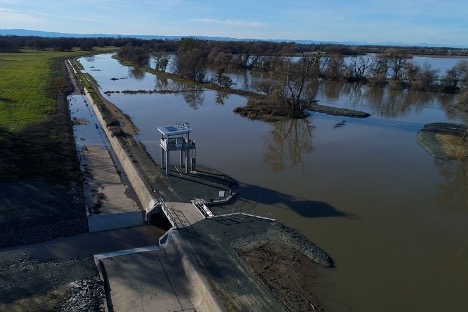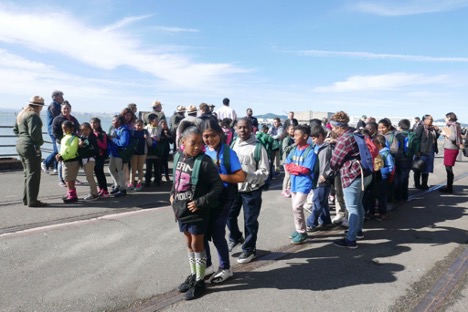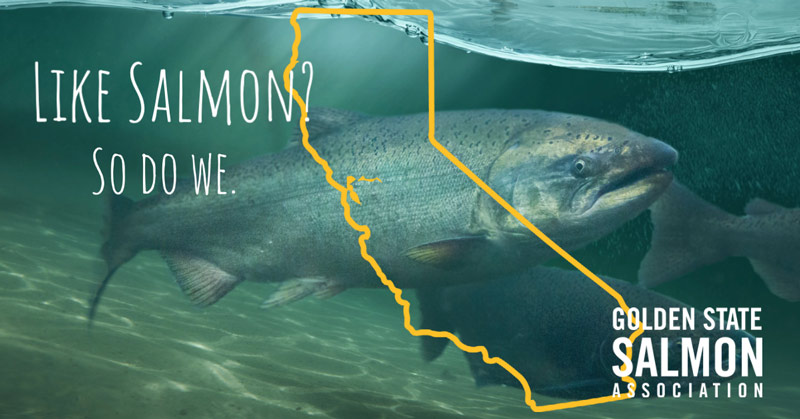Season Over, Hatchery Updates

Salmon are still being caught in Central Valley rivers as we write. Returns have been not great, to put it mildly, but it’s starting to look like all of the hatcheries will hit their egg targets. This did not appear to be the case until recently. In the third week of November, after a second rain system dropped moisture on Northern California, a new and very welcome pulse of fish showed up in the Mokelumne River. This took a lot of stress off the hatchery operators. Reports from Coleman and Feather River hatcheries indicated they achieved their egg take targets but not by much. Some egg loss at hatcheries is common due to disease and other factors. Hopefully the hatcheries will all produce their target number of smolts for release next spring. Of special concern, production of “enhancement” fish used to stock the Half Moon Bay net pen and the Santa Cruz and Monterey releases. Enhancement fish are also the ones released at Ft. Baker in Sausalito. All of the enhancement release sites see much higher survival since they’re closer to the ocean which minimizes losses to predation as the baby salmon go to sea. All of the enhancement fish are produced at the Mokelumne hatchery. Worried they wouldn’t get enough eggs, CDFW agreed to bring several million eggs down from the Feather River hatchery to keep the enhancement program going.
Yolo Bypass Big Notch update

Work by the state to eventually comply with federal law requiring the Yolo Bypass be made more accessible to migrating juvenile salmon is moving. If we’re lucky we could see groundbreaking by the fall of 2021. Although the original federal order to broaden access of juvenile salmon to the bypass came in 2009, we say better late than never. Engineers have settled on the design of what’s called the “big notch” which will be a breach in the Fremont Weir that separates the bypass from the Sacramento River. This will allow the Sacramento, and juvenile salmon, to flow into the bypass when it reaches a certain height. A concern is if the the new bypass flows will undermine adjacent levees in the bypass. If so, the conveyance canal from the notch into the bypass will require reinforcement to protect the levees. This could set the project back. Soil tests are currently being analyzed to answer the question. Once the project is built and running, it’s anticipated that any baby salmon that get washed into the bypass will instantly benefit fromgood food supplies created in the bypass as well as good rearing habitat in the southern bypass where it empties into the western Delta. An added bonus is they’ll be deposited into the Delta far enough west to be beyond the deadly pull of the Delta pumps.
New team in DC needs to learn about California salmon

With the election of Joe Biden we hope to see a different direction coming from federal water and wildlife agencies that affect salmon populations in the Central Valley. A new commissioner will be appointed to head the Bureau of Reclamation which runs the big dams and water projects. New people will be appointed to oversee the National Marine Fisheries Service, US Fish and Wildlife Service and other agencies. Interested stakeholders are already vying to get their visions and ideas heard.
Regardless of who they hear from, the Biden administration will have to decide fairly early on what they want to do about the legal challenges to the Trump administration’s Delta pumping rules which allow seizure and export of an additional 600,000 additional acre feet of water, above existing levels, from salmon rivers and the environment. These rules were challenged because pumping levels were already far in excess of what science considers sustainable for maintaining salmon and other species prior to them. Will the Biden administration defend in court environmentally damaging pumping levels inherited from the Trump administration? Seems unlikely, although big ag operators throughout especially the San Joaquin Valley wish they would. Who will the Biden team listen to when deciding how to proceed? One can imagine they’ll hear from the Democratic governor of California who on the one hand is suing to get the Trump pumping rules tossed and on the other approved very similar pumping rules for the massive state Delta pumps.
Then there’s the case for raising Shasta Dam, which the Trump administration continued to push as they were being pushed out the door. What will the Biden team do about that? Whose counsel will they seek?
The big water users in the San Joaquin Valley will continue to demand unsustainable levels of water exports from northern California salmon rivers to grow their almonds for export mostly to China and India. Although they overwhelmingly backed Biden’s opponent, how will the Biden team deal with their demands?
Of note, Senator Kamala Harris worked closely with Rep. Jared Huffman’s office on legislation to address water problems in California. Unlike her counterpart, Senator Feinstein, the Harris bill calls for salmon-friendly, sustainable approaches to addressing the long term water problems that have plagued Central Valley salmon. Hopefully when voices demanding more unsustainable and environmentally damaging water policies come seeking an audience, this experience will help salmon fishermen and women.
GSSA calculates that no matter what, we’re going to need to elbow our way into the mob to get a voice for salmon to the table along with all the others.
Multiple delta habitat restoration projects are moving

After juvenile salmon flush down the Sacramento River they often hit the Delta while still too small to go to sea. Historically they’d find areas in the freshwater sections of the Delta to rear and hopefully avoid predators. Much of the habitat they used was lost when farmers disconnected it from the Delta with dikes so they could farm it or convert it into duck hunting clubs. Recently two major efforts to restore some of this habitat have made major advances. One effort, near Montezuma Slough, had to dump tons of dredged sediment on top of ground that had subsided after being disconnected from the tidal action of the Delta. The land had fallen to an elevation of four to six feet below sea level, protected by the surrounding levees. Officials brought in barges full of dredged sediment from elsewhere in the bay and Delta, built the submerged lands back to above sea level and then cut the levees to allow tidal flows in and out. This should restore the land to a similar ecological function as that which was destroyed. In the second development, the state has given its legal blessing to a huge project also aimed at restoring tidal connection to the Delta, this time for some 3400 acres diked off long ago. The project proponents, a private equity group, is banking on its ability to deliver legally required restored habitat, at a profit, much cheaper than the state. We’re guessing they’re going to win this bet. They plan to bust down the dikes in the spring.
CDFW waffles on Richmond net pen

GSSA, working with the East Bay Municipal Utility District (EBMUD) and others haveproposed putting a net pen in the Richmond Marina where up to 200,000 baby salmon might be reared and released. The project would benefit many, including local underserved communities that would be invited to participate in the rearing and release of these fish. Assuming they’d return as adults, as other net penned fish do, these fish could also provide a unique opportunity for local people in and around Richmond to supplement their dinner table. GSSA has won the support of the mayor and Richmond Marina harbor master. EBMUD supports the plan. The CDFW is dragging its feet, concerned about bureaucratic issues. We are working to address and overcome their objections.
Membership drive, Online Auctions seek to fill the gap

GSSA is now in the year-end membership renewal drive. We’ve added different membership levels and by renewing now, we’ll toss your name in to a raffle where 35 of you will win great prizes. View Prizes Here

We’re also accepting donations, and all are tax deductible, including in-kind donations of goods, services, trips, etc. You may want to rack up some major tax deductions before the end of the year when you won’t be able to anymore.
If you’re cash poor but sitting on loads of stock that went through the roof this past year and you want to kill two birds with one stone, consider donating a few shares to GSSA and take the write off at the face value of the stock in today’s price. Anyone who bought Tesla knows what we’re saying. Same for Apple, Netflix and many others.
Shasta Dam Raise, federal Bureau of Reclamation finalizes planning document but no action likely
In a bizarre move, the federal Bureau of Reclamation finalized a planning document in November, ostensibly clearing the way for approval of the Shasta Dam raising project. Bizarre because it’s most unlikely they plan, or can, do anything with it. A press release announcing the action included a rambling list of Trump administration favors to the San Joaquin Valley big water users, all having nothing to do with raising Shasta. Raising Shasta can’t happen under existing law without the approval of Congress, something not likely to happen with the current makeup of the Congress. Trapping hundreds of thousands of additional acre feet of water needed by salmon has been a long time dream of San Joaquin Valley types who have overdrawn their own aquifers to the point of causing their lands to subside.
